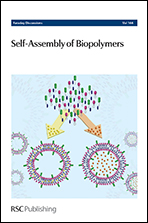Electrospinning of peptide and protein fibres: approaching the molecular scale†
Abstract
For the example of peptides and proteins, we contrast “natural” self-assembly, i.e. aggregation in solutions, with “forced” assembly by electrospinning, i.e. by application of strong electrical fields to concentrated solutions. We were able to spin fibres that contain short stretches of diameters down to 5 nm; the ultimate aim is a fibre of the size of a single molecule. Besides their wide biochemical relevance, small peptides can assemble to defined supramolecular structures such as fibres and tubes. While the main driving mechanism in electrospinning is certainly based on electrostatics, aromatic groups in peptides might play a directing role. We used fluorenyl and phenyl, whose π-stacking is not manifested in vibrational spectra, but is clearly visible in their crystal structures. The main differences between solid phases and single molecules are found for O–H and N–H stretching and bending vibrations, due to extensive hydrogen bonding in solids. However, we found that only proteins, but not peptides, can be spun into ultrathin fibres. Therefore, nanoscale analysis by SEM and AFM, and by infrared near-field microscopy are especially useful. The comparison of the amide bands from the infrared and Raman spectra, combined with circular dichroism spectroscopy, allowed us to assign secondary structures. Our results are not only useful for interpreting and refining current theories of self-assembly and electrospinning, but also for creating new scaffolds for the growth of sensitive cells.
- This article is part of the themed collection: Self-Assembly of Biopolymers

 Please wait while we load your content...
Please wait while we load your content...